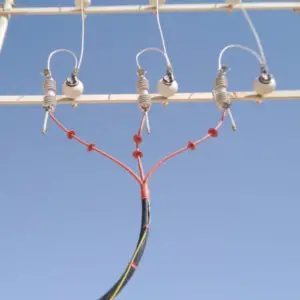When it comes to electrical connections, safety should always be the top priority. Connecting wires by twisting them together might seem like a quick and easy solution, but it can pose significant risks.
In this article, we’ll dive deep into the reasons why you shouldn’t connect wires by twisting them together, what the standards say, and safer alternatives.
Table of Contents
Why Twisting Wires Together Is Risky

One of the main risks of twisting wires together is the potential for a loose or unreliable connection.
When wires are twisted, they can easily come apart, especially if they are not secured with proper insulation or a connector.
Loose connections can cause electrical arcing, which can generate heat and spark a fire.
Another risk of twisting wires together is the possibility of creating a high-resistance joint. If wires are not twisted tightly enough, the contact area between them can be reduced, leading to increased resistance and potential overheating.
Twisting wires together can also make it difficult to identify which wires are connected to each other. This can lead to confusion and mistakes when troubleshooting or making changes to the wiring.
What the Standards Say
- The National Electric Code (NEC) is a set of standards that specifies requirements for electrical installations in the United States. According to NEC 110.14, electrical connections should be made in a manner that ensures a “good and safe” electrical connection, and that “cannot be easily disturbed or pulled apart”. While the NEC does not explicitly prohibit twist-on connections, it requires that they be used in accordance with the manufacturer’s instructions and installed in a manner that provides a secure connection.
- The International Electrotechnical Commission (IEC) develops international standards for electrical and electronic technologies. IEC 60364-5-52 specifies requirements for electrical installations in low-voltage systems. According to this standard, connections between conductors should be made using appropriate connectors or terminal blocks. Although twist-on connections are not specifically mentioned, they are generally not recommended for use in permanent installations.
- Similarly, the European Committee for Electrotechnical Standardization (CENELEC) develops European standards for electrical and electronic technologies. EN 60364-5-52 is the European equivalent of IEC 60364-5-52 and contains similar requirements for electrical installations. The standard recommends the use of appropriate connectors or terminal blocks for making connections between conductors and does not specifically recommend twist-on connections for permanent installations.
In summary, while the NEC does not explicitly prohibit twist-on connections, it requires that they be used in a manner that provides a secure connection.
The IEC and CENELEC standards recommend the use of appropriate connectors or terminal blocks for making connections between conductors, and twist-on connections are generally not recommended for use in permanent installations. It’s essential to follow these standards to ensure safe and reliable electrical installations.
Safer Alternatives to Twisting Wires Together
There are several alternatives to twisting wires together that are safer and more reliable. One of the most common methods is to use wire connectors or terminals.
These are devices that are designed to securely connect wires together while also providing insulation and strain relief.
Another alternative is to use crimp connectors. These are devices that are attached to the ends of wires using a crimping tool, creating a secure and reliable connection.
Soldering is another option for connecting wires, but it requires more skill and specialized equipment. Soldering creates a strong and reliable connection, but it can also introduce new risks if not done correctly, such as overheating or creating cold solder joints.
Comparison Table
To help you compare the pros and cons of different wire connection methods, here’s a comparison table:
| Method | Pros | Cons |
|---|---|---|
| Twisting Wires | Quick and easy | Unreliable, potential for high-resistance or loose joints |
| Wire Connectors | Secure, insulated, strain relief | More expensive, may require special tools or knowledge |
| Crimp Connectors | Secure, reliable, strain relief | Requires specialized crimping tool and skill |
| Soldering | Strong, reliable | Requires specialized equipment and skill |
Conclusion
Connecting wires by twisting them together might seem like a simple solution, but it can pose significant risks to safety and reliability.
The National Electrical Code allows twisting wires only in specific circumstances, and even then, it should be covered with an appropriate connector or tape.
To ensure safe and reliable connections, it’s best to use approved methods and materials, such as wire connectors or crimp connectors.
By following the standards and using safe connection methods, you can help prevent electrical accidents and ensure the safety of your home or workplace.
Don’t Leave Empty-Handed!
Install my Free Android App on Google Play:
Electrical Cables Most Common Tables “Cables Tables”
And, my Electrical Calculations App “Fast Electrical Calculator”
Discover more great content by subscribing to My channel
Looking to stay ahead of the game in the world of electrical engineering? Subscribe to my YouTube channel and gain access to exclusive content you won’t find anywhere else!
The staff I recommend
(Amazon Affiliate Links to products I believe are high quality):
- Economy 120 Volt/60Hz AC Power Source – Step-Down Voltage & Frequency Converters 1800W
- UNI-T Digital Multimeter Tester UT139C
- 50-Amp Extension Cord for RV “100ft”
- Voltage Stabilizer 110/220v
- Hair Dryer “best selling“
- TOSHIBA EM131A5C-BS Countertop Microwave Ovens
Disclaimer: This contains affiliate links to Amazon products. I may earn a commission for purchases made through these links.



